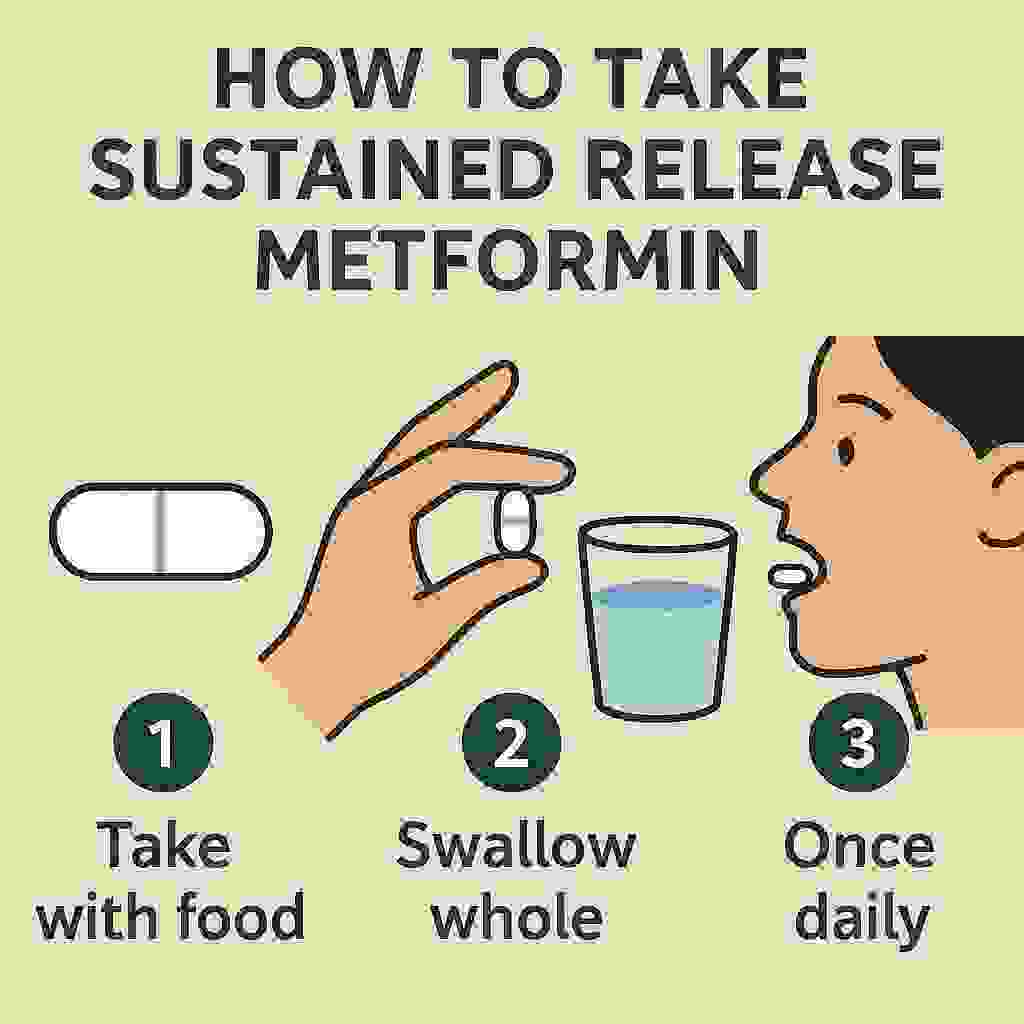How to Start Taking Sustained Release Metformin?
- admin
- July 13, 2025
- 2:10 am
- No Comments

If you are embarking on a journey with diabetes management, your doctor may suggest switching to sustained-release (SR) metformin.
This version is designed to release the medicine slowly throughout the day, offering more stable blood sugar control and fewer gastrointestinal side effects.
In this guide, Best Dietary Supplement for Diabetics research team shall walk through each step—from timing and dosing to monitoring and adjusting—all in clear, conversational language.
You shall finish fully prepared, confident, and empowered to work with your medical team.
This Article Covers:
- Understanding Sustained‑Release Metformin Benefits
- Confirm Your Eligibility and Kidney Health
- Starting SR Metformin: First-Day Tips
- Titrating Dose: How and When to Increase
- Managing Gastrointestinal Side Effects
- Monitoring Blood Glucose and Kidney Function
- Combining SR Metformin with Lifestyle Changes
- FAQs on Taking Sustained Release Metformin
- When to Consult Your Doctor or Switch Back
Understanding Sustained‑Release Metformin Benefits
When your doctor prescribes sustained-release metformin (also known as SR, XR, or Glucophage XR), you are choosing a version that slowly dissolves in your gut. This smoother release reduces the peaks and dips in medication concentration that can upset your stomach.
Clinical studies confirm that SR metformin provides comparable blood glucose control—measured by A1c levels—to immediate-release versions, but with fewer side effects and a lower daily pill burden—often just one dose per day instead of two or three.
That means less stomach discomfort and hassle.
If you have ever experienced nausea or diarrhea when starting metformin, switching to SR could be a game-changer.
Confirm Your Eligibility and Kidney Health
Before beginning SR metformin, your doctor will check your kidney function—this is crucial. Doctors look at your eGFR, and most guidelines say SR metformin is fine if your eGFR is above 45 mL/min/1.73 m².
If it is between 30 and 45, they shall weigh risks with caution.
Below 30? SR metformin is contraindicated.
New standards from 2025 reinforce this approach, calling for regular kidney checks, especially for seniors.
Since sustained-release formulations stay in your system longer, it is essential your body can clear the drug safely.
Your doctor might run blood tests before you start, then periodically after initiation—often every 6–12 months. This ensures your kidneys stay healthy and medication stays effective.

Starting Sustained Release Metformin: First-Day Tips
On Day 1, your doctor typically starts you on 500 mg SR once a day with your evening meal. Taking it with food slows absorption further and helps reduce the chance of digestive upset.
Some forms may start at 1000 mg, but most begin low and go slow. The key is consistency—take it at the same time each evening.
You might feel minor changes during the first few days: slight stomach discomfort or increased gas can happen as your gut adjusts.
If that occurs, consider eating fiber-rich foods or sipping herbal tea. Staying hydrated helps too.
By launching with food, low and slow, you give your body a gentle introduction—building the foundation for a smoother treatment journey.
Titrating Dose: How and When to Increase?
After starting sustained-release metformin at the standard beginner dose of 500 mg once daily, most healthcare providers follow a weekly titration plan. This means your dose may increase by 500 mg every 7 days, assuming you are tolerating it well.
For example, in Week 2, you might move up to 1000 mg once daily. If that goes smoothly, Week 3 could be 1500 mg, and finally, Week 4 brings you to 2000 mg once daily—which is often the maximum effective dose for many adults.
However, metformin is not one-size-fits-all. Some people may find that jumping from 1000 to 1500 mg causes mild stomach upset or bloating. If that happens, your provider might suggest staying on your current dose for another week or even stepping back temporarily. The key is not to rush—your body needs time to adjust.
In certain cases, if blood sugar levels remain stubbornly high, your provider might split the 2000 mg dose into 1000 mg twice daily, especially if you’re on an extended-release tablet that allows flexible dosing. This can also help with side effect management in more sensitive individuals.
Your healthcare team will monitor your progress with fasting blood sugar readings and HbA1c levels every few weeks or months. Their aim is to find the lowest effective dose that keeps your glucose levels in a healthy range—without triggering side effects.
This individualized, stepwise approach helps ensure you are getting the full benefit of sustained-release metformin, while minimizing discomfort along the way. Think of it as easing into a warm bath—not diving headfirst.
Managing Gastrointestinal Side Effects
Even with SR formulations, some people experience stomach upset—common culprits include nausea, gas, bloating, and diarrhea. Research shows these GI symptoms often peak within 1–2 weeks and typically improve with continued use.
To reduce them:
- Take the pill with a large meal.
- Avoid spicy or fatty foods shortly after taking it.
- Try taking probiotic foods like yogurt or kefir.
- Use over-the-counter antacids or simethicone as needed.
- Avoid alcohol, which can worsen GI effects and increase lactic acidosis risk.
If symptoms persist beyond two weeks or are severe, speak with your provider. Sometimes, spreading the dose or temporarily reducing it helps.
Most people adapt fully after a few weeks and report significantly improved tolerance compared to immediate-release forms.
Monitoring Blood Glucose and Kidney Function
Once on SR metformin, tracking progress is key to achieving safe, effective results.
Your doctor will likely ask you to:
- Test blood sugar at least once a day—fasting, post-meal, or as directed.
- Return for lab tests after 6–12 weeks to gauge A1c change.
- Repeat kidney function (eGFR) assessments every 6–12 months.
If your morning fasting glucose stays within target and A1c drops by about 0.7–1.5% after three months, you’re headed in the right direction.
Renal monitoring ensures your body clears the drug safely, protecting against the rare but serious risk of lactic acidosis.
Swift action on abnormal labs may involve dose adjustment or switching therapy. These monitoring routines keep your treatment both effective and safe.
Combining SR Metformin with Lifestyle Changes
Metformin, especially in its sustained-release (SR) form, is a powerful tool—but it is not a magic bullet. It works best when paired with lifestyle changes that support insulin sensitivity and overall metabolic health.
Think of SR metformin as a reliable teammate—it can carry a good portion of the load, but it needs you to run the plays.
Your Diet:
Let us start with diet. SR metformin works more efficiently when your meals are balanced.
Whole grains like brown rice and oats, lean proteins such as chicken or tofu, and plenty of colorful vegetables provide steady energy without spiking blood sugar.
Swap sugary cereals with steel-cut oats, and replace white bread with whole grain or sourdough.
Avoid alcohol as drinking alcohol impacts blood sugar levels dramatically.
Add a handful of almonds or Greek yogurt between meals to prevent glucose dips.
Your Exercise Pattern:
Then there is exercise. Aim for 150 minutes per week of moderate activity.
That does not mean hitting the gym daily—brisk walking after dinner, dancing in your living room, or riding a bike on weekends count too.
Even a 10-minute walk after each meal can help reduce post-meal blood sugar spikes.
Your Body Weight:
Weight management also plays a crucial role. SR metformin may contribute to modest weight loss—typically 4 to 7 pounds over several months.
Pair that with portion control or intermittent fasting (with your doctor’s okay), and results can improve significantly.
One patient I worked with simply cut soda and added two evening walks a week—and dropped two inches off his waist in 90 days.
To stay on track, try using a food journal, step counter, or a fitness app like MyFitnessPal. These small tools can create big motivation.
Bottom line: Sustained Release metformin does not replace healthy habits—it enhances them.
When the two work together, it becomes easier to stabilize blood sugar, manage cravings, maintain energy, and protect your long-term health.
FAQs on the Art of Taking Sustained Release Metformin
Q1: How should I begin taking sustained-release metformin?
A1: Start with a low dose, typically 500 mg once daily with your evening meal. This approach minimizes gastrointestinal side effects. After about two weeks, your doctor may adjust the dose based on your blood sugar levels. The maximum recommended daily dose is 2,000 mg.
Q2: How do I adjust the dosage of sustained-release metformin over time?
A2: Your doctor will gradually increase your dose, usually by 500 mg increments every one to two weeks, depending on your blood sugar control and tolerance. This gradual titration helps reduce the risk of side effects.
Q3: When is the best time to take sustained-release metformin?
A3: Take the medication once daily with your evening meal. This timing helps maintain steady blood sugar levels overnight and reduces gastrointestinal discomfort.
Q4: Can I switch from immediate-release to sustained-release metformin?
A4: Yes, transitioning is possible. Your doctor will determine the appropriate equivalent dose and monitor your response to ensure effective blood sugar control.
Q5: What should I do if I miss a dose of sustained-release metformin?
A5: If you miss a dose, take it as soon as you remember, unless it’s almost time for your next dose. In that case, skip the missed dose and continue with your regular schedule. Do not take two doses at once to make up for a missed dose.
Q6: Are there any dietary considerations when taking sustained-release metformin?
A6: It is advisable to take metformin with meals to reduce gastrointestinal side effects. Additionally, maintain a balanced flexitarian diet and monitor your blood sugar levels regularly to assess the medication’s effectiveness.
When to Consult Your Doctor or Switch Back?
Stay alert to circumstances that require provider contact:
- Persistent diarrhea, vomiting, or stomach pain
- Signs of lactic acidosis (rare): deep rapid breathing, unusual tiredness, muscle pain
- Kidney function declines below safe levels (eGFR falls below 45)
- Planning surgery or contrast scans—your doctor may temporarily stop metformin
In some cases, despite a slow-release formula, your body may still struggle with side effects or specific health changes.
If so, your doctor may switch you back to immediate-release, adjust the timing, or try another medication. Staying informed and responsive to your own symptoms ensures your treatment remains effective and comfortable.

Takeaway: Your Next Steps to Effective SR Metformin Use
In summary, starting sustained-release metformin involves eight thoughtful steps—from picking the right dose and scheduling to monitoring, adjusting, and integrating with healthy habits.
This method minimizes side effects, maximizes benefits, and keeps big complications at bay. If you follow a steady titration plan, take it with meals, monitor your blood sugar levels, and tweak your lifestyle, you are setting yourself up for success.
If side effects or blood sugar control becomes a challenge, your doctor can help tailor the plan—whether that means slowing the increase, refining your dose, or considering alternatives. You are not alone on this path.
With smart adjustments, regular check-ins, and lifestyle support, sustained-release metformin can become a reliable, efficient part of your diabetes toolkit.
References: